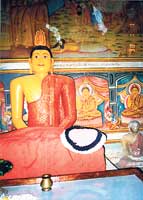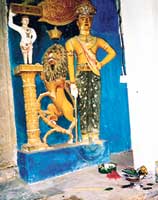
The many legends surrounding Pasgama Raja Maha ViharayaThe Pasgama Raja Maha Viharaya was built during the time of King Walagamba and the Bodhi Tree in the premises is from an 'Ankura' (sapling) from the Sri Maha Bodhi in Anuradhapura. This was stated by Hewawisse Wimaladharma Thera, the resident thera of the Viharaya who spoke of the history and legends of the Raja Maha Viharaya and the adjoining Natha Devalaya. Viharadhipathi Hewavisse Siriniwasa Nayaka Thera, who is also the Patha Hewaheta Upapradhana Sangha Nayake was away at the time The Sunday Times visited the vihara. Hanguranketha, in the Kanda Udarata is a historic place, surrounded by the Nillambha Oya on the west, Belihuloya on the east, the Mahaweli on the north and the Piduruthalagala mountain on the south. It is divided into two zones , Hath Hewaheta and Uda Hewaheta. There are 30 villages in Uda Hewaheta and three Korala. Each Korala had ten villages. This was during the early times.
"During the Gampala 'yugaya' (period) Patha Hewaheta was divided into two sections as Sagama Rata and Pasgam Rata. Later Sagama Rata was known as Gam Dahaye Koralaya and Pasgam Rata as Hewavissa Koralaya. Accordingly Sagama Rata had ten villages and Pasgam Rata had twenty villages (gam vissa). Hence, Hewavissa. Pasgama Viharaya is in Hewavissa," the Thera explained. The Thera said that there is a rock inscription in Hewavissa where it is stated that King Watta Gamini Abhaya had come to Pasgama and constructed a wall round the Bodhi tree at the Pasgama Raja Maha Viharaya. It is also believed that King Wickramabahu III had visited Pasgama and constructed the Natha Devalaya and placed a statue of the deity Natha. The Raja Maha Viharaya was in ruins during the time of King Rajasinghe II according to writings in ancient Talipot leaves and many items from the Viharaya were handed over to the Natha Devalaya by the King. During King Veera Parakrama Narendrasinghe, the devalaya was improved while King Keerthi Sri Rajasinghe improved the viharaya. The Thera explained that earlier the viharaya and devalaya conducted two separate peraheras. However, during the time of King Keerthi Sri Rajasinghe, they were combined as one and continue as such upto the present time. This perahera is conducted yearly after the Sri Dalada Maligawa Perahera in Kandy. The Pasgama Viharaya is affiliated to the Asgiriya Maha Viharaya in Kandy through the Medapitiye Pansala. The Thera stated that during the time of the kings, Theras from the Pasgama Viharaya were on 'Thevawa' duty at the Sri Dalada Maligawa, but not now, he laments. The Pasgama Perahera consists of five inside Peraheras, 5 Kumbal, 5 Randoli and one Daval (Day) Perahera. For the Diya Kepeema on the last night of the Randoli Perahera, it winds its way to Ma Oya in Hanguranketa, a distance of about two miles. It has to traverse through hills and paddy fields cutting across villages. About four elephants take part in this perahera and even walk on the narrow 'Niyara' of the paddy fields ! The 'Deva Abharana' (insignia) of the deity is taken by the 'Kapurala' of the devalaya wrapped in a white cloth. Once a year the 'Nanumura Mangalya' is performed on the Buddha statue (washing the statue with a mixture of medicinal herbs, sandalwood etc.). This is performed on the 'Parana Avurudu Day (the day before the Sinhala New year in April). M.G. Karunadasa, a villager from Marassana, Hewavissa spoke of the folklore connected with the Pasgama Viharaya and the Devalaya. It is believed that during the time of the perahera, every year a white elephant had come down from the jungle and stood near the Natha Devalaya.
"The villagers would tie the 'Karanduwa' on its back and the tusker would go in the perahera. Once it was over, the tusker would return to the jungle. One day the tusker did not come to perform its duty. So, the villagers went to the jungle in search of the animal. Sadly, they found a dead tusker fallen from a rock. They cut the tusks and brought it to the viharaya." Karunadasa further states that it is believed King Walagamba patronized the Pasgama Viharaya and the Queen went to the Thalawa Viharaya, which is close by. Therefore, the tusks were cut in two and the top half given to Pasgama and the bottom section to the Thalawa Viharaya. At present these are with the trustee, stated Karunadasa. Karunadasa related another story associated with the Pasgama Natha Devalaya."At Kanda Handiya, a man was on his way to his 'hena'(chena) to till his land. for cultivation. He met an old man who had said he has to go on a journey with the farmer. The farmer had refused saying he had to prepare his land for cultivation. But the old man had insisted and said to hide the 'Keththa' which he took to clear the jungle land and come with him. The farmer did so. They walked for some time and sat on a rock. The old man inquired whether the other was hungry and if so at the 'yatipatte gedera' (in the house below )there is a 'Hath Ambule Adukkuwa' (rice and curry) and to go and eat it. The farmer went as he was instructed, had his meal and returned to the rock. But the old man was not to be seen. There was only a foot print on the rock! So, the villager went back home and slept. In a dream the old man appeared and said "I have left my walking stick in a certain place. Build a Devalaya on that spot." The next day when the villager went to 'Hena' his land was tilled! "Today this place is known as Kethigannawa in Kanda Handiya" stated Karunadasa. It is believed that the Natha Devalaya is built on the particular spot where the old man had left his walking stick - according to folklore. |
|| Front
Page | News | Editorial | Columns | Sports | Plus | Financial
Times | International | Mirror | TV
Times | Funday
Times | Kandy
Times || |
| |
Reproduction of articles permitted when used without any alterations to contents and the source. |
© Copyright
2007 | Wijeya
Newspapers Ltd.Colombo. Sri Lanka. All Rights Reserved. |

